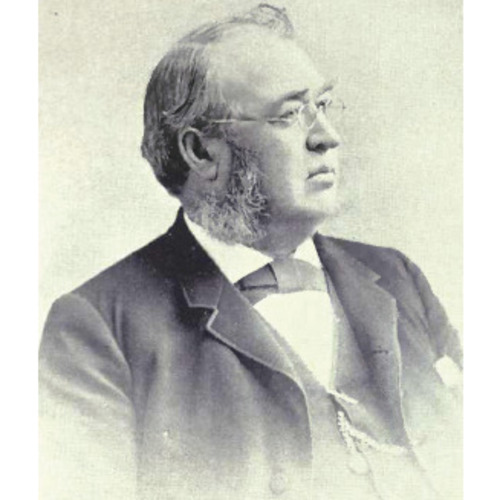
Source: Link
TEAGUE, JOHN, contractor and architect; b. June 1833 in Cornwall, England; m. July 1863 Emily Abington, and they had four children; m. secondly December 1892 Eliza Lazenby in Victoria; d. there 25 Oct. 1902.
John Teague left England on 19 May 1856, intending to join an uncle in Costa Rica. American military action in Central America that year caused him to stop in New York, however, and he changed his destination to California, where a gold-rush was on. He found work as a general contractor, erecting buildings for mining companies. In 1858 he set off for the Fraser gold-fields of British Columbia, passing through Victoria on the way, and he participated in the Cariboo gold-rush of 1859.
By 1860 Teague was back in contracting and construction work, this time for the Royal Navy at Esquimalt, on Vancouver Island, and the many surviving naval works for which he was responsible attest to his competence as an engineer. In the middle of the decade he was advertising himself as both architect and contractor and had established an office in Trounce Alley, Victoria. His first documented commission dates from 1874 and was for the Church of Our Lord, a congregation of the Reformed Episcopal Church. He saw Victoria change from a town of fewer than 5,000 people to a city of some 35,000, political capital of British Columbia, and major manufacturing centre for the Pacific northwest. His practice followed the curve of its rapid growth.
Teague’s aggressive approach to business and his political connections enabled him to squeeze other architects from prominence, and his practice became one of the most successful in Victoria’s history. More than any other person, he set the tone for the city’s commercial architecture from the late 1870s to the early 1890s. His influence is still evident in the old business district, where he did dozens of blocks. His commercial buildings, such as the Turner, Beeton and Company warehouse (1882), are for the most part no-nonsense brick structures with an economical use of Victorian Italianate applied ornament. The influences seem to be Californian, reflective of his own background and that of the majority of his business clientele. Indeed, for the most part the smaller commercial structures of San Francisco, Portland, Oreg., and Victoria erected during these years are almost indistinguishable. In later works such as the Driard Hotel, completed in 1892, Teague experimented with the Chicago School style.
From his office also derived many of Victoria’s most significant civic, ecclesiastical, and residential buildings. He did not persevere with the High Victorian Mansard style that he used in the 1870s for the Victoria City Hall and the Masonic Temple. Again he showed himself most at home in the Italianate idiom. The St Joseph’s, Royal Jubilee, and Royal Navy hospitals, the residences erected in 1885 for brick manufacturer Maurice Humber, the Roman Catholic bishop, and the Prior family, the storekeeper’s house for the Admiralty in Esquimalt (1885), and St Ann’s Academy (1886) were products of his lucrative and prolific practice.
An active Presbyterian and freemason, Teague served as an alderman and was twice mayor of the city. He belonged to the British Columbia Pioneer Society and was indeed typical of those pioneers whose energy was exceeded only by their individual vision and ambition. Generous in his loans to friends and unwise in his investments, he died in 1902 with about as much to his name as he had had when he first arrived in Victoria four decades earlier.
City of Victoria Arch., 98410-30, George Gardner scrapbooks, 3: 51–54; City clerk’s office, ser.11, 1862–80; Fast information files, John Teague, biog. sketch. John Adams, Historic guide to Ross Bay Cemetery, Victoria, B.C., Canada (Victoria, 1983). Kerr, Biog. dict. of British Columbians. J. I. Manore, “The navy and Victoria,” Heritage West (Vancouver), 8 (1984), no.1: 12–13. G. E. Mills, Architectural trends in Victoria, British Columbia, 1850–1914 (Parks Can., National Hist. Parks and Sites Branch, Manuscript report, no.354, 2v., Ottawa, 1976; copy in City of Victoria Arch.). Northwestern Rev. of Seattle (Seattle, Wash.), 1 (1891), no.5: 30–31 (copy in City of Victoria Arch.). Martin Segger and Douglas Franklin, Victoria: a primer for regional history in architecture (Watkins Glen, N.Y., and Victoria, 1979). Carolyn Smyly, “Heritage lost: a lament for vanished landmarks of Victoria,” Western Living (Vancouver), 6 (1976), no.10: 22–26, 109. Victoria illustrated; published under the auspices of the City of Victoria . . . (Victoria, 1891).
Cite This Article
Martin Segger, “TEAGUE, JOHN,” in Dictionary of Canadian Biography, vol. 13, University of Toronto/Université Laval, 2003–, accessed January 12, 2026, https://www.biographi.ca/en/bio/teague_john_13E.html.
The citation above shows the format for footnotes and endnotes according to the Chicago manual of style (16th edition). Information to be used in other citation formats:
| Permalink: | https://www.biographi.ca/en/bio/teague_john_13E.html |
| Author of Article: | Martin Segger |
| Title of Article: | TEAGUE, JOHN |
| Publication Name: | Dictionary of Canadian Biography, vol. 13 |
| Publisher: | University of Toronto/Université Laval |
| Year of publication: | 1994 |
| Year of revision: | 1994 |
| Access Date: | January 12, 2026 |



